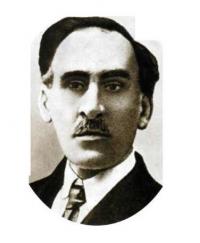Aleksandr Vasiljevich Fomin (1869-1935) was a botanist. He studied ferns and seed plants. He was also a director of the Kiev University Botanical Garden; which was renamed after him, when he died. He was a subject of the Russian Empire and later the Soviet Union.
Aleksandr Vasiljevich Fomin | |
|---|---|
 Fomin, before 1935 | |
| Born | 2 May 1869 Ermolevka, Petrovsk, Saratov Oblast, Russia |
| Died | 16 October 1935 (aged 66) |
| Nationality | Ukrainian |
| Alma mater | Kiev Taras Shevchenko University |
| Known for | Taxonomy Botany |
| Scientific career | |
| Fields | Botany |
| Author abbrev. (botany) | Fomin |
Biography
editHe was born in the village of Ermolevka in Petrovsk, Saratov Oblast on (14 May [O.S. 2 May] 1869.[1]
From 1888 to 1890, Fomin along with Nicolaĭ Adolfowitsch Busch and Nikolai Ivanovich Kuznetsov, funded by the Russian Geographical Society, took several botanical and geographical expeditions to the Caucasus.
In 1893, he graduated from Moscow University.[1]
In 1896, he became a graduate assistant at the Universität Dorpat (now known as the University of Tartu, Estonia).[1]
Foin, Busch and Kuznetsov later wrote 'Flora Caucasica critica' (Materially dlia flory Kavkaza : kriticheskoe sistematichesko-geograficheskoe izsliedovanie),[2] which was published between 1901 and 1913. It was written as a special supplement to the journal 'Trudy Sankt-Peterburgskogo obshchestva estestvoispytatelei', v. 31, pt. 3, 1901, and v. 34, pt. 3 1905–1908.[3] This published several new species of plant including, Arabidopsis pumila,[4]
In 1902 he became a botanist at the Tbilisi Botanical Gardens.[1][5]
Between 1907 and 1919, he wrote 'Kavkaza i Kryma' (Flora of the European part of Russia, An illustrated key to the wild plants of European part of Russia and Crimea) with Yury Nikolaevich Voronov, about plant species in the Caucasus. Although, it was unfinished due to the start of the First World War.[6] He also wrote in 1907 'Cucurbitaceae i Companulaceae flory Kaukaza'.[7]
In 1914, Fomin became a professor at the University of Kiev, (under O. Fomin).[1][8]
Between 1914 and 1935, he served as director of the Saint Vladimir University Botanical Garden, Kiev, Ukraine. During the severe winter of 1919–1920, he and his team saved many green-house plant collections from the frost.[9]
In 1921, he founded the National Herbarium of Ukraine, which holds his specimens.[10][11]
In 1922, Fomin founded the botany department at the Botanical Garden, that was reorganized in 1927 into the 'Scientific-Research Botany Institute' (now the Institute of Botany named after Kholodny Academy of Sciences of Ukraine).
When he died in 1935, the university renamed the garden, the A.V. Fomin Botanical Garden.[12]
An extensive collection of species collected from the Caucasus is stored within the sheltered herbarium at University of Tartu, in Estonia.[13]
He is the botanical author of many species including; Allium atroviolaceum, Allium callidyction, Allium rupestre, Astragalus cyri, Asyneuma lobelioides, Campanula Andina, Campanula Armena, Campanula bayerniana, Campanula besenginica, Campanula raddeana, Campanula petrophila, Campanula daghestanica, Campanula longistyla, Campanula sibirica, Campanula suanetica, Centaurea daralagoezica, Crocus suwarowianus, Cryptogramma brunoniana, Fritillaria michailovskyi, Galanthus transcaucasicus, Iris acutiloba var. schelkowinkowii, Myriophyllum spicatum, Pseudomuscari forniculatum. Tulipa schmidtii[5][14]
Although, he has collaborated on some publications with Alexander Alfonsovich Grossheim on many articles.
He is mentioned in D.J. Mabberley portable plant books of 1997.[16][17]
Several botanical species have been named in his honor,[18] including; Cirsium fominii Petr., Crinitaria fominii ( Kem.-Nath. ) Czerep., Campanula fominii Grossh. Kolak. & Serdyuk., Colchicum fominii Bordz., Polystichum × fominii Askerov & A.Bobrov, Juncus fominii Zoz, Acinos fominii Shost.-Desiat., Acantholimon fominii Kusn. and Atropis fominii Bilyk.
References
edit- ^ a b c d e The Great Soviet Encyclopedia, 3rd Edition. 1970–1979. Retrieved 6 October 2014.
- ^ Flora Caucasica critica = Materialy dlia flory Kavkaza : kriticheskoe sistematichesko-geograficheskoe. Vol. ch.3 vyp.3. biodiversitylibrary.org. Retrieved 1 October 2014.
- ^ "Flora Caucasica critica". uk.ipni.org (International Plants Names Index). Retrieved 1 October 2014.
- ^ "Details for: Arabidopsis pumila". January 2011. Retrieved 4 October 2014.
- ^ a b Mitchell, Alan, ed. (2013). "Lilies and related plants" (PDF). RHS Lily Group. p. 79. Archived from the original (PDF) on 6 October 2014. Retrieved 2 October 2014.
- ^ David G. Frodin Guide to Standard Floras of the World: An Annotated, Geographically Arranged , p. 675, at Google Books
- ^ A.V Fomin Cucurbitaceae i Companulaceae flory Kaukaza at Google Books
- ^ "History". univ.kiev.ua. Retrieved 6 October 2014.
- ^ "Fomin botanical garden". mykiev.info. Archived from the original on 4 August 2013. Retrieved 1 October 2014.
- ^ Shiyan, Natalia M; Korniyenko, Olga M; Mosyakin, Sergei L (2012). "National Herbarium of Ukraine (KW)". doi:10.13140/RG.2.1.2809.3843.
{{cite journal}}: Cite journal requires|journal=(help) - ^ "Herbarium Details - M.G. Kholodny Institute of Botany, National Academy of Sciences of Ukraine". The William & Lynda Steere Herbarium. Retrieved 12 October 2022.
- ^ "Kyiv. Botanical Garden named after Fomin. Palm trees bloom in the winter". kpi.ua. 2008-01-04. Retrieved 6 October 2014.
- ^ "Natural History Museum of Tartu University (TU), the herbarium of vascular plants" (in Estonian). natmuseum.ut.ee. Retrieved 1 October 2014.[permanent dead link]
- ^ "Sritis:Aleksandr Vasiljevich Fomin" (in Russian). lietuvai.lt. Retrieved 1 October 2014.
- ^ International Plant Names Index. Fomin.
- ^ D. J. Mabberley The Plant-book: A Portable Dictionary of the Vascular Plants (2nd Edit), p. 823, at Google Books
- ^ D. J. Mabberley The Plant-book: A Portable Dictionary of Plants, their cultivation and uses, p. 981, at Google Books
- ^ Harold T. Clifford, Peter D. BostockEtymological Dictionary of Grasses, p. 115, at Google Books